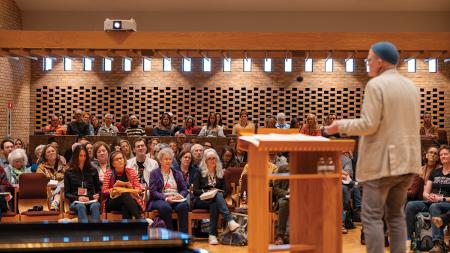Stories of Growth and Renewal

Part of the renewal story at New Hope Church is an increased focus on leadership development.
The Christian Reformed Church in North America is joining with congregations across the U.S. and Canada to help address the issue of a declining membership through various strategies of renewal and growth.
In the past decade, the CRCNA seen a more than 13 percent decline membership, with many congregations feeling this decline in their own worship-service attendance — and wondering what they can do about it.
At its annual, decision-making meeting in June 2017, in fact, synod discussed this trend and encouraged churches and denominational staff to make church renewal a priority.
“There are many ways a church can experience growth and renewal, whether in the number of people in the pews or in ways that are harder to measure, such as greater unity, richer prayer life, or a growing focus on outreach,” said Darren Roorda, Canadian Ministries Director, “but one thing seems sure: it doesn’t happen by accident. It happens with intentionality and reliance on God.”
Renewal starts with a church intentionally deciding to work at renewal. Many Christian Reformed congregations have been doing just that through Health and Renewal Grants from Sustaining Congregational Excellence (SCE), through the work of Classis Renewal, and through participation in the Church Renewal Lab of Calvin Theological Seminary and other initiatives.
Each has its own story. “Ultimately all credit goes to God,” said Roorda, “but that should not minimize our intentional plans and participation. We simply make our plans and intentions in prayer, being willing to change or adapt them as we understand God's guiding."
Here are a few stories of congregations in British Columbia, Alberta, and Illinois whose experiences reflect just some of the ways that CRC churches are experiencing renewal.
A Church Retreat Leads to Renewed Focus
Sometimes church renewal requires a boost. New Hope Church in Lansing, Ill., started in 2008 as a merger of two smaller congregations: First CRC of Lansing and New Community Fellowship of Hammond, Ill. Dan Roels, pastor of New Hope Church, would say that the church has been renewing slowly since 2008 as members of both congregations came together and as new people joined their community. In the summer of 2016, during a church retreat funded partly by a grant from SCE, this renewal took a leap forward as goals of the church came more clearly into focus.
“People wanted to have a lot of different new ministries, new programs, new outreaches,” said Roels. “But in the midst of thinking about that, we realized, ‘Wait a minute – we don’t have leaders for anything new.’”
So the congregation decided to focus on developing new leaders, encouraging them to serve in the church and on its council. By including younger members and members who had only known New Hope Church – not its “parent” churches – they hoped to set a new tone for the future, aiming for a renewed leadership and focus.
The congregation is also looking at the possibility of a sanctuary remodel, said Roels. The current building was home to First CRC of Lansing since 1919. While noting that a renovation project is not in itself a recipe for renewal, Roels said it can be a sign of things already happening.
“People are interested in New Hope Church, and hopefully when they’re here, they hear the gospel. And if we can create an environment that’s welcoming, they’re going to be able to hear it a little bit better,” said Roels. “But renewal will be very much connected to prayer and a renewed focus on outreach. Without those two things, remodeling the sanctuary would just be cosmetic.”
The church’s focus on prayer is tangible in a few ways. About once each year, church members do a prayer walk, simply going out into the neighborhood and praying about what they see as they walk streets and sidewalks. It’s a way of “taking church with you” once you’ve left the church building, said Roels.
They have also scheduled a prayer volunteer each Sunday, who sits in a spot in the balcony and prays during the worship service. Roels can see the person while he’s preaching. “That’s always an encouragement to me, to know that the service is being prayed over and prayed through,” he said.
To help equip church members for outreach, church leaders are working on a “toolbox” of resources. They led an event in the fall to help people be prepared to give a brief account of the gospel or a personal testimony. And this winter, they hope to hold an apologetics class.
Further, to encourage closer relationships with people who might not be connected to a church, New Hope members are getting involved in groups and activities outside of the church, with the idea that a person can take a hobby or interest, get involved in the community around that, and just “show up and be a Christian there,” said Roels.
Relaunching as a Satellite Brings New Energy
Sometimes church renewal can come out of the wake of decline. Mundy Park Christian Fellowship was a Christian Reformed church with diminishing numbers in Coquitlam, B.C. Fifty years into the life of the church, about 30 or 40 people sat in the pews most Sundays, and about four kids formed the Sunday school. Members were concerned about the future of the ministry.
Early in 2016, the church approached a 12-year-old CRC church plant called The Tapestry to discuss what it might look like for the churches to work together. After a lot of discussion and prayer from both churches, church members at Mundy Park voted overwhelmingly in favor of merging with The Tapestry, becoming a satellite campus of the popular multisite church.
Within a year after discussions began, Mundy Park Christian Fellowship closed its doors and began the transition to becoming The Tapestry: Mundy Park. Part of the process involved a “period of rest,” said Sam Lee, pastor of the new satellite church. “There was a ceasing of services . . . a period where there was a clear end to the previous congregation, and then a brand-new launch a month and a half later as a new entity.” In the six weeks of rest, members attended other churches, including other Tapestry campuses, and shared a dinner celebrating the years that they had been a church together and looking forward to the new launch.
Since then, the congregation has doubled in size, and its Sunday school includes more than 20 children. Changes were made to the building and grounds to reflect the new things happening there, and worship services went through some updates.
Albert Chu, The Tapestry’s lead pastor, noted, “[Mundy Park Christian Fellowship] used to run as a traditional CRC church, with the very traditional liturgy. . . . We’ve changed the time of the service, brought in a worship band, run a kids’ camp, done block parties. . . .”
Church members who had been part of Mundy Park Christian Fellowship have responded well to the changes, said Lee. With 50 years of history, they recognized that the close-knit church circle would have been hard for new people to “break into.” “When you push a reset button,” he reflected, “there’s a new sense of a new story being told, and opportunity for people to say, ‘Hey, I’d like to be part of that story too!’”
Other changes have seen a greater focus on small groups, mixing old and new members, people of a diversity of ages and ethnic backgrounds, and meeting more frequently than in previous years. The church has also picked up a Tapestry tradition of holding Service Sundays, on which there is no formal church service and members go into the community to do acts of service, such as clearing invasive species out of a forest near the church, visiting a seniors home, and spending time with refugees.
One new member is working on starting a community garden that will tie in with the daycare service renting space in Mundy Park’s building. Kids in the daycare will spend time each day watering the garden and learning about plant care.
“It’s like a new marriage in some ways,” said Lee. “The two partners are still kind of getting to know each other . . . forming the new family identity. We’re six months in, trying to find that togetherness. . . . There certainly are growing pains, and needing to be stretched, but that’s part of the process.”
Investing in Community by Becoming Community
Renewal can also happen through a change in the physical space of a church’s location. The River Community CRC in Edmonton, Alta., meets each week in South Pointe Community Centre — but, in a way, you could say that the community meets in The River. The church leases space in the facility, which seats 1,100 people, and the relationship is more than tenant-landlord. When The River moved into the facility, they partnered with the owner to open it as a community center.
Bruce Gritter, lead pastor at The River, is also president of the South Pointe Community board. Having helped plant a number of churches in the Edmonton area, Gritter had many connections to the community, and a passion for seeing the gospel spread further in the city. When the opportunity came to move into the large facility, he saw the chance to meet a community need — providing a place of assembly — while also moving into a space that would give The River room to grow.
“We’ve got the church planting side of the equation, so we’ll keep on pushing at developing new churches,” said Gritter, “and then there’s the South Pointe side of the equation, which is a whole new way of thinking about church. It’s learning to be a church within a community center, and to make the community center thrive as well.”
As a community center, the building hosts theater and dance groups, boy scouts, cultural festivities, orchestras, and other community groups. “You name it, we’ve got it functioning in the building,” said Gritter.
One prospect that Gritter is working on now is creating an after-school program to be launched out of South Pointe Community Centre. The program, funded by a government grant, will welcome students of all ages and belief systems and will be run as a program of South Pointe.
Because Gritter is the president of South Pointe’s board, though, he can choose the staff. “Who am I going to choose? I’m going to choose people that understand the vision of influence. We won’t run the after-school program as a Christian program, but we’ll staff it with Christians,” he said.
This kind of community interaction has created some challenges, he admits; it restricts opportunities for “church activity” time spent in the building, and it requires finding a balance regarding staff, scheduling, and facility management.
But the opportunities it presents are very much worthwhile, according to Gritter. “It’s given us the sense that the boundaries between our [church] community and the community around us are a lot thinner now, because we interact with each other in a whole bunch of different ways. It’s a unique opportunity.”
Is your church in the process of renewal? Do you have an interesting renewal story to tell? Consider sharing it with others on The Network and label it in the category of “church renewal.”


